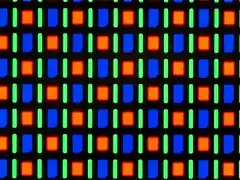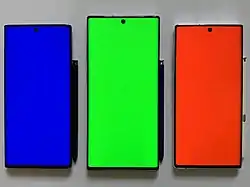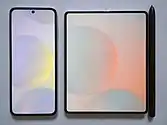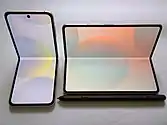AMOLED
AMOLED (active-matrix organic light-emitting diode, /ˈæmoʊˌlɛd/) is a type of OLED display device technology. OLED describes a specific type of thin-film-display technology in which organic compounds form the electroluminescent material, and active matrix refers to the technology behind the addressing of pixels.

Since 2007, AMOLED technology has been used in mobile phones, media players, TVs and digital cameras,[1] and it has continued to make progress toward low-power, low-cost, high resolution and large size (for example, 88-inch and 8K resolution) applications.[2][3][4].

Design

An AMOLED display consists of an active matrix of OLED pixels generating light (luminescence) upon electrical activation that have been deposited or integrated onto a thin-film transistor (TFT) array, which functions as a series of switches to control the current flowing to each individual pixel.[5]
Typically, this continuous current flow is controlled by at least two TFTs at each pixel (to trigger the luminescence), with one TFT to start and stop the charging of a storage capacitor and the second to provide a voltage source at the level needed to create a constant current to the pixel, thereby eliminating the need for the very high currents required for passive-matrix OLED operation.[6]
TFT backplane technology is crucial in the fabrication of AMOLED displays. In AMOLEDs, the two primary TFT backplane technologies, polycrystalline silicon (poly-Si) and amorphous silicon (a-Si), are currently used offering the potential for directly fabricating the active-matrix backplanes at low temperatures (below 150 °C) onto flexible plastic substrates for producing flexible AMOLED displays.[7]
History
AMOLED was developed in 2006. Samsung SDI was one of the main investors in the technology, and many other display companies were also developing it. One of the earliest consumer electronics products with an AMOLED display was the BenQ-Siemens S88 mobile handset[8] and, in 2007, the iriver Clix 2 portable media player.[9] In 2008 it appeared on the Nokia N85 followed by the Samsung i7110 - both Nokia and Samsung Electronics were early adopters of this technology on their smartphones.[10]
Future development
Manufacturers have developed in-cell touch panels, integrating the production of capacitive sensor arrays in the AMOLED module fabrication process. In-cell sensor AMOLED fabricators include AU Optronics and Samsung. Samsung has marketed its version of this technology as "Super AMOLED". Researchers at DuPont used computational fluid dynamics (CFD) software to optimize coating processes for a new solution-coated AMOLED display technology that is competitive in cost and performance with existing chemical vapor deposition (CVD) technology. Using custom modeling and analytic approaches, Samsung has developed short and long-range film-thickness control and uniformity that is commercially viable at large glass sizes.[11]
Comparison to other display technologies
Compared to other display technologies, AMOLED screens have several advantages and disadvantages.
AMOLED displays can provide higher refresh rates than passive-matrix, often have response times less than a millisecond, and they consume significantly less power.[12] This advantage makes active-matrix OLEDs well-suited for portable electronics, where power consumption is critical to battery life.
The amount of power the display consumes varies significantly depending on the color and brightness shown. As an example, one old QVGA OLED display consumes 0.3 watts while showing white text on a black background, but more than 0.7 watts showing black text on a white background, while an LCD may consume only a constant 0.35 watts regardless of what is being shown on screen. Of course a new FHD+ or WQHD+ display will consume much more. [13] Because the black pixels turn completely off, AMOLED also has contrast ratios that are significantly higher than LCDs.[14]
AMOLED displays may be difficult to view in direct sunlight compared with LCDs because of their reduced maximum brightness.[15] Samsung's Super AMOLED technology addresses this issue by reducing the size of gaps between layers of the screen.[16][17] Additionally, PenTile technology is often used for a higher resolution display while requiring fewer subpixels than needed otherwise, sometimes resulting in a display less sharp and more grainy than a non-PenTile display with the same resolution.
The organic materials used in AMOLED displays are very prone to degradation over a relatively short period of time, resulting in color shifts as one color fades faster than another, image persistence, or burn-in.[18][19]
Flagship smartphones sold in 2020 and 2021 used either a Super AMOLED. Super AMOLED displays, such as the one on the Samsung Galaxy S21+ / S21 Ultra and Samsung Galaxy Note 20 Ultra have often been compared to IPS LCDs, found in phones such as the Xiaomi Mi 10T, Huawei Nova 5T, and Samsung Galaxy A20e.[20][21][22] For example, according to ABI Research, the AMOLED display found in the Motorola Moto X draws just 92 mA during bright conditions and 68 mA while dim.[23] On the other hand, compared with the IPS, the yield rate of AMOLED is low; the cost is also higher.
Marketing terms
Super AMOLED
"Super AMOLED" is a marketing term created by Samsung for an AMOLED display with an integrated touch screen digitizer: the layer that detects touch is integrated into the display, rather than overlaid on top of it and cannot be separated from the display itself. The display technology itself is not improved. According to Samsung, Super AMOLED reflects one-fifth as much sunlight as the first generation AMOLED.[24][25] The generic term for this technology is One Glass Solution (OGS).
Comparison
Below is a mapping table of marketing terms versus resolutions and sub-pixel types. Note how the pixel density relates to choices of sub-pixel type.
| Term | Reso- lution |
size (inches) |
PPI | Color depth
(bits) |
Pixel layout |
Used in |
|---|---|---|---|---|---|---|
| AMOLED | 320×240 | 2.2 | 182 | iriver clix 2 | ||
| 2.6 | 154 | RGBG PenTile | Nokia N85 | |||
| AMOLED Capacitive Touchscreen |
640×360 | 3.2 | 229 | Nokia C6-01 | ||
| Super AMOLED | 3.5 | 210 | RGB S-Stripe | Nokia N8 | ||
| 4.0 | 184 | Nokia 808 PureView | ||||
| 720×720 | 3.1 | 328 | BlackBerry Q10 | |||
| 854×480 | 3.9 | 251 | RGBG PenTile | Nokia N9 | ||
| 800×480 | 4.0 | 233 | Samsung Galaxy S | |||
| 960×540 | 4.3 | 256 | RGB S-Stripe | Samsung Galaxy S4 Mini | ||
| 1280×768 | 4.5 | 332 | RGBG PenTile | Nokia Lumia 1020 | ||
| Super AMOLED Plus | 800×480 | 4.3 (4.27) | 218 | RGB stripe | Samsung Galaxy S II | |
| Super AMOLED Advanced | 960×540 | 4.3 | 256 | RGBG PenTile | Motorola Droid RAZR | |
| HD Super AMOLED | 1280×800 | 5.3 (5.29) | 285 | Samsung Galaxy Note | ||
| 1280×720 | 5.0 | 295 | RGB S-Stripe | BlackBerry Z30 Samsung Galaxy J7 Samsung Galaxy J5 Samsung Galaxy E5 Samsung Galaxy J3 (2016) | ||
| 4.7 (4.65) | 316 | RGBG PenTile | Samsung Galaxy Nexus | |||
| 4.7 (4.65) | 316 | RGB S-Stripe | Moto X (1st generation) | |||
| 4.8 | 306 | RGBG PenTile | Samsung Galaxy S III | |||
| 5.6 (5.55) | 267 | RGB S-Stripe | Samsung Galaxy Note II | |||
| 5.6 (5.55) | 267 | Samsung Galaxy Note 3 Neo | ||||
| HD Super AMOLED Plus | 1280×800 | 7.7 | 197 | RGB stripe | Samsung Galaxy Tab 7.7 | |
| Full HD Super AMOLED | 1920×1080 | 5.5 | 400 | RGBG PenTile | Meizu MX5 | |
| 5.0 (4.99) | 441 | Samsung Galaxy S4 | ||||
| 5.0 (4.99) | 441 | OnePlus X | ||||
| 5.0 (4.99) | 441 | Google Pixel | ||||
| 5.2 | 423 | Motorola Moto X (2nd gen) | ||||
| 5.1 | 432 | Samsung Galaxy S5 | ||||
| 5.5 | 401 | OnePlus 3 OnePlus 3T OnePlus 5 | ||||
| 5.7 | 388 | Samsung Galaxy Note 3 | ||||
| Full HD+ Super AMOLED | 2160×1080 | 6.0 | 402 | Google Pixel 3 | ||
| 6.0 | 402 | Huawei Mate 10 Pro | ||||
| 2220x1080 | 6.01 | 411 | Samsung Galaxy A8+ (2018) | |||
| Full HD+ Super AMOLED | 2220x1080 | 5.61 | 441 | Samsung Galaxy A8 (2018) | ||
| Super Retina HD | 2436×1125 | 5.8 (5.85) | 458 | Apple iPhone X iPhone XS iPhone 11 Pro | ||
| 2688×1242 | 6.5 (6.46) | iPhone XS Max iPhone 11 Pro Max | ||||
| WQHD Super AMOLED | 2560×1440 | 5.1 | 577 | Samsung Galaxy S6 Samsung Galaxy S6 Edge Samsung Galaxy S6 Active Samsung Galaxy S7 Samsung Galaxy S7 Active | ||
| 5.2 | 564 | Microsoft Lumia 950 | ||||
| 5.2 | 565 | Motorola Droid Turbo | ||||
| 5.4 | 540 | BlackBerry Priv | ||||
| 5.5 | 534 | BlackBerry DTEK60 Samsung Galaxy S7 Edge Google Pixel XL Alcatel Idol 4S vodafone smart platinum 7(Alcatel Sol Prime) Moto Z Moto Z Force ZTE Axon 7 | ||||
| 5.7 | 515 | 8 | Samsung Galaxy Note 4 Samsung Galaxy Note 5 Samsung Galaxy S6 Edge+ Nexus 6P Samsung Galaxy Note 7 | |||
| 5.7 | 518 | Microsoft Lumia 950 XL | ||||
| 2960×1440 | 5.8 | 571 | Samsung Galaxy S8 Samsung Galaxy S9 | |||
| 6.2 | 529 | Samsung Galaxy S8+ Samsung Galaxy S9+ | ||||
| 6.3 | 521 | Samsung Galaxy Note 8 | ||||
| 6.4 | 514 | Samsung Galaxy Note 9 | ||||
| WQXGA Super AMOLED | 2560×1600 | 8.4 | 359 | Samsung Galaxy Tab S 8.4 | ||
| 10.5 | 287 | RGB S-Stripe | Samsung Galaxy Tab S 10.5 | |||
| 3K AMOLED | 2880×1600 | 3.5 | 615 | (unknown) | HTC Vive Focus Plus[26] | |
| Dynamic AMOLED | 2280x1080
3040x1440 2280x1080 3040x1440 3040x1440 |
5.8
6.1 6.3 6.4 6.8 |
438
550 401 522 498 |
Samsung Galaxy S10e | ||
| Fluid AMOLED | 3120x1440 | 6.67 | 516 | OnePlus 7 Pro | ||
| Dynamic AMOLED 2X | 2208×1768
2400x1080 3200x1440 |
7.6
6.1 6.4 6.7 6.8 6.9 |
373 (Display resolution for Samsung Galaxy Z Fold 2) 386 (External display resolution for Samsung Galaxy Z Fold 2) 563 525 511 421 394 515 411 374 (Display resolution for Samsung Galaxy Z Fold 3) |
RGBG PenTile | Samsung Galaxy Z Fold 2
Samsung Galaxy S20+ Samsung Galaxy S20 Ultra (Samsung Galaxy Note 20) (Samsung Galaxy Note 20 Ultra) Samsung Galaxy S21+ Samsung Galaxy S21 Ultra Samsung Galaxy S21 FE Samsung Galaxy Z Fold 3 Samsung Galaxy S22+ Samsung Galaxy S22 Ultra Samsung Galaxy S23+ Samsung Galaxy S23 Ultra |
Future
Future displays exhibited from 2011 to 2013 by Samsung have shown flexible, 3D, transparent Super AMOLED Plus displays using very high resolutions and in varying sizes for phones. These unreleased prototypes use a polymer as a substrate removing the need for glass cover, a metal backing, and touch matrix, combining them into one integrated layer.[27]
So far, Samsung plans on branding the newer displays as Youm,[28] or y-octa.[29]
Also planned for the future are 3D stereoscopic displays that use eye-tracking (via stereoscopic front-facing cameras) to provide full resolution 3D visuals.
References
- Lee, Hyunkoo; Park, Insun; Kwak, Jeonghun; Yoon, Do Y.; Kallmann, Changhee Lee (2010). "Improvement of electron injection in inverted bottom-emission blue phosphorescent organic light emitting diodes using zinc oxide nanoparticles". Applied Physics Letters. 96 (15): 153306. Bibcode:2010ApPhL..96o3306L. doi:10.1063/1.3400224.
- Kim, Yang Wan; Kwak, Won Kyu; Lee, Jae Yong; Choi, Wong Sik; Lee, Ki Yong; Kim, Sung Chul; Yoo, Eui Jin (2009). "40 Inch FHD AM-OLED Display with IR Drop Compensation Pixel Circuit". SID Symposium Digest of Technical Papers. 40: 85. doi:10.1889/1.3256930. S2CID 110871831.
- Lee, Myung Ho; Seop, Song Myoung; Kim, Jong Soo; Hwang, Jung Ho; Shin, Hye Jin; Cho, Sang Kyun; Min, Kyoung Wook; Kwak, Won Kyu; Jung, Sun I; Kim, Chang Soo; Choi, Woong Sik; Kim, Sung Cheol; Yoo, Eu Jin (2009). "Development of 31-Inch Full-HD AMOLED TV Using LTPS-TFT and RGB FMM". SID Symposium Digest of Technical Papers. 40: 802. doi:10.1889/1.3256911. S2CID 110948118.
- Hamer, John W.; Arnold, Andrew D.; Boroson, Michael L.; Itoh, Masahiro; Hatwar, Tukaram K.; Helber, Margaret J.; Miwa, Koichi; Levey, Charles I.; Long, Michael; Ludwicki, John E.; Scheirer, David C.; Spindler, Jeffrey P.; Van Slyke, Steven A. (2008). "System design for a wide-color-gamut TV-sized AMOLED display". Journal of the Society for Information Display. 16: 3. doi:10.1889/1.2835033. S2CID 62669850.
- "Introduction to OLED Displays – Design Guide for Active Matrix OLED (AMOLED) Displays" (PDF). 4D Systems. 22 May 2008. Archived from the original (PDF) on 5 July 2010. Retrieved 6 September 2010.
- Lin, Chih-Lung; Chen, Yung-Chih (2007). "A Novel LTPS-TFT Pixel Circuit Compensating for TFT Threshold-Voltage Shift and OLED Degradation for AMOLED". IEEE Electron Device Letters. 28 (2): 129. Bibcode:2007IEDL...28..129L. doi:10.1109/LED.2006.889523. S2CID 11194344.
- Sarma, Kalluri R.; Chanley, Charles; Dodd, Sonia R.; Roush, Jared; Schmidt, John; Srdanov, Gordana; Stevenson, Matthew; Wessel, Ralf; Innocenzo, Jeffrey; Yu, Gang; O'Regan, Marie B.; MacDonald, W. A.; Eveson, R.; Long, Ke; Gleskova, Helena; Wagner, Sigurd; Sturm, James C. (2003). "Active-matrix OLED using 150°C a-Si TFT backplane built on flexible plastic substrate (Proceedings Paper)". SPIE Proceedings. 5080: 180. doi:10.1117/12.497638. S2CID 12958469. "Archived copy" (PDF). Archived from the original (PDF) on 28 June 2011. Retrieved 2010-09-06.
{{cite web}}: CS1 maint: archived copy as title (link) - "Active OLEDs close in on mobile phone market".
- "Iriver clix2 Review". www.anythingbutipod.com. Archived from the original on 28 October 2007. Retrieved 19 April 2022.
- "The Consumer Electronics Hall of Fame: Nokia N85 Cellphone". 13 December 2018.
- Reid Chesterfield, Andrew Johnson, Charlie Lang, Matthew Stainer, and Jonathan Ziebarth, "Solution-Coating Technology for AMOLED Displays Archived 16 May 2011 at the Wayback Machine", Information Display Magazine, January 2011.
- Suyko, Alan. "Oleds Ready For The Mainstream." Electronics News (2009): 20. Associates Programs Source Plus. Web. 9 Dec. 2011.
- Dong, Mian; Choi, Yung-Seok Kevin; Zhong, Lin (2009). "Power modeling of graphical user interfaces on OLED displays". Proceedings of the 46th Annual Design Automation Conference on ZZZ - DAC '09. p. 652. doi:10.1145/1629911.1630084. ISBN 9781605584973. S2CID 442526.
- "AMOLED vs LCD: differences explained". Android Authority. 8 February 2016. Archived from the original on 27 December 2016. Retrieved 6 February 2017.
- Tim Carmody (10 November 2010). "How Super AMOLED displays work". Wired. Archived from the original on 28 September 2012. Retrieved 10 October 2012.
- "What Are The Benefits Of Using The Super AMOLED Display In My SGH-t959 (Vibrant) Phone?". Samsung. 15 July 2010. Archived from the original on 16 July 2011. Retrieved 7 September 2010.
- "Big is beautiful". The Age. 12 August 2010. Archived from the original on 29 August 2010. Retrieved 7 September 2010.
- Ashtiani, Shahin J.; Reza Chaji, G.; Nathan, Arokia (2007). "AMOLED Pixel Circuit With Electronic Compensation of Luminance Degradation". Journal of Display Technology. 38 (1): 36. Bibcode:2007JDisT...3...36A. doi:10.1109/JDT.2006.890711. S2CID 44204246.
- US 7352345, Chun-huai Li, "Driving apparatus and method for light emitting diode display", issued 2008-04-01
- "AMOLED vs LCD: Which screen is best for your phone?". digitaltrends.com. 29 August 2014. Archived from the original on 29 March 2018. Retrieved 6 May 2018.
- "Smartphone screens explained: display types, resolutions and more - AndroidPIT". androidpit.com. Archived from the original on 12 May 2015. Retrieved 6 May 2018.
- "Nexus 4 Review: Not Exactly Perfect, But Close Enough For Me – TechCrunch". techcrunch.com. Archived from the original on 7 February 2018. Retrieved 6 May 2018.
- Google/Motorola Mobility Display a Bright Efficient Future, ABI Research
- "Samsung Smartphones | Technology". Samsung.com. 6 January 2012. Archived from the original on 27 June 2012. Retrieved 10 October 2012.
- "Super AMOLED". Oled-info.com. Archived from the original on 9 October 2012. Retrieved 10 October 2012.
- "HTC VIVE Focus Plus". vive.com. Archived from the original on 13 December 2017. Retrieved 30 July 2021.
- "Samsung teases flexible, transparent display in concept video". engadget.com. Archived from the original on 11 October 2016. Retrieved 6 May 2018.
- "Samsung names flexible OLED display series 'Youm', shows new prototype handheld device". engadget.com. Archived from the original on 16 February 2018. Retrieved 6 May 2018.
- Kelly, Gordon. "Samsung Report 'Confirms' Significant Galaxy S9 Design Changes". forbes.com. Archived from the original on 1 April 2018. Retrieved 6 May 2018.
External links
- Craig Freudenrich. Types of OLEDs: Passive and Active Matrix at HowStuffWorks

